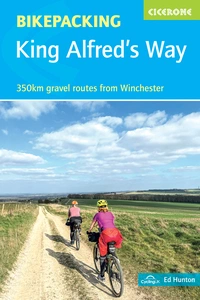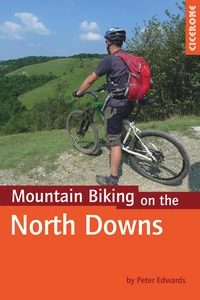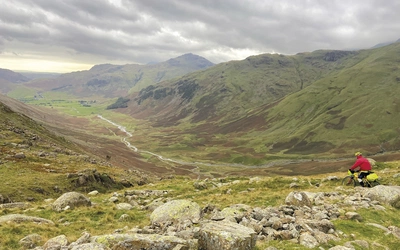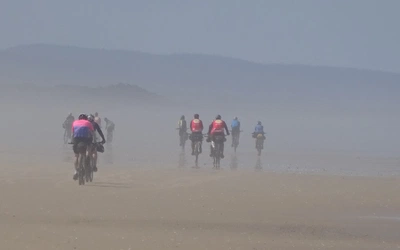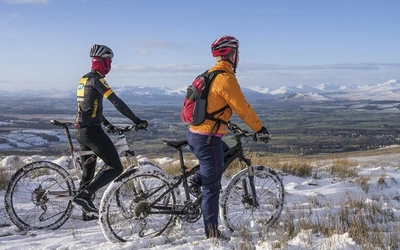Bikepacking King Alfred's Way: a conversation with Ed Hunton
Bikepacking King Alfred’s Way offers a journey through some of southern England’s most evocative landscapes, weaving together chalk downs, wooded hillsides, ancient tracks and quiet river valleys. We caught up with author Ed Hunton to hear how he first fell in love with adventure cycling, why this route continues to inspire him, and what riders can expect when they set out along this celebrated 350km circuit.
Bikepacking King Alfred's Way
353km gravel loop from Winchester
£16.95
Guidebook to bikepacking King Alfred's Way. The 353km circular route from Winchester explores some of England's most iconic landscapes and ancient sites. Devised by Cycling UK, the route is split into 7 stages and is suitable for beginners and experienced riders with a decent level of fitness.
More information
Hi Ed! Can you tell us a bit about how you got into cycling and bikepacking?
My first long ride was a trip to Cornwall to visit my Gran when I was 14. Later tours were inspired by my partner’s dad, John Spur, who ran the Hot Pursuit bike shop in Totnes. I edged gradually into bikepacking by adding more mixed terrain to European road tours. My first big off-road route was over the Sierra Nevada in Spain in 2010, following the highest navigable road in Europe. At the heart of it all has been a love of exploration and a desire to take a bike into exposed, varied landscapes, far from crowds and traffic.
Growing up in North Devon on the edge of Dartmoor, how did that landscape shape your love of adventure on two wheels?
Necessity is the mother of invention. I lived in an isolated spot in North Devon and needed a bike to get around and see my friends. The rolling hills, quiet lanes, big skies and echoes of both prehistoric and pre- and post-industrial landscapes always promoted a sense of mystery and the unknown.
What inspired you to write Bikepacking King Alfred’s Way?
King Alfred’s Way was the first fully established route I rode that made me want to curate routes myself. It brings together many of the standout features of this part of England, including significant prehistoric sites. I felt I could build on Cycling UK’s superb original route and bring together everything a rider might need, from accommodation and refreshment stops to access points and escape options. The aim was to support riders of all abilities to shape the journey that suits them best.
How does King Alfred’s Way differ from your previous bikepacking routes in terms of terrain, scenery or challenge?
The route links a striking variety of landscapes, from chalk streams to Salisbury Plain, Cranborne Chase, the Ridgeway, the Thames Valley and the North and South Downs. At 350km it's a long ride, and the terrain rolls constantly, but it is not as tough as the steepest routes in the Lake District. The main challenge is keeping your water supplies topped up.
Could you share any memorable moments from researching the route?
One October afternoon we had just finished lunch at the Devil’s Punch Bowl cafe. As we were preparing to set off, a window cleaner across the road was working away with a portable radio blasting out the opening bassline of Bon Jovi’s Living on a Prayer. He was swaying from side to side, completely absorbed. We joined in singing. Then a man watering his plants next door started playing air guitar with his watering can. By the time the chorus came around there were five of us belting it out. We rode off, punching the air, singing that we were 'halfway there... livin' on a prayer', and we had indeed just passed the halfway point.
Are there particular highlights or favourite sections along the route you’d recommend?
Plenty. The second half of stage two across Salisbury Plain is fantastic for big skies and easy progress through wild country. Section three over All Cannings Down is superb. One of the most exhilarating stretches follows the western edge of the North Downs through woodland and heath.
How does the route reflect the history, culture or landscape of the areas it passes through?
The route traverses an area of England steeped in history, with human activity recorded in every millennium since Neolithic times. The culture embedded in the landscape is strongly influenced by the region’s Anglo-Saxon heritage, reflected in historic towns, churches and settlements. Rural life, including livestock and arable farming, carries local customs, while country traditions, festivals and crafts have developed alongside this agricultural legacy. Together, these elements give the region its distinctive character.
Are there any insider tips you can share for making the most of the experience?
Plan your refreshment stops and overnight stays, and take every opportunity to refill water bottles. Take your time to explore. Stop and take in the landscape, visit the country pubs and tea rooms, and make sure you investigate Wayland’s Smithy!
If you're new to bikepacking, make sure your bike is well serviced, choose a route between two train stations, keep your first day short with a stop at a campsite, and gradually increase the difficulty and complexity of your adventures.
What sort of bike and equipment do you recommend for King Alfred’s Way?
A gravel bike with a wide gear ratio and 40 to 45 millimetre tyres, or a hardtail mountain bike. I always take a toolkit, two water bottles, a head torch and a battery pack.
What do you enjoy most about bikepacking? The freedom, the challenge, or something else?
The freedom to explore places I have never seen, while still presenting a challenge. It allows me to get under the hood of an area and step away from modern urban living for a few days.
Do you have any upcoming projects or routes you are excited to explore next?
I am working on three more bikepacking guides: The Yorkshire Dales and North Yorkshire Moors, Bikepacking West Country Gravel, and Classic Bikepacking Routes in Europe by ferry and train.
Good luck with them all!
Bikepacking King Alfred's Way
353km gravel loop from Winchester
£16.95
Guidebook to bikepacking King Alfred's Way. The 353km circular route from Winchester explores some of England's most iconic landscapes and ancient sites. Devised by Cycling UK, the route is split into 7 stages and is suitable for beginners and experienced riders with a decent level of fitness.
More information
